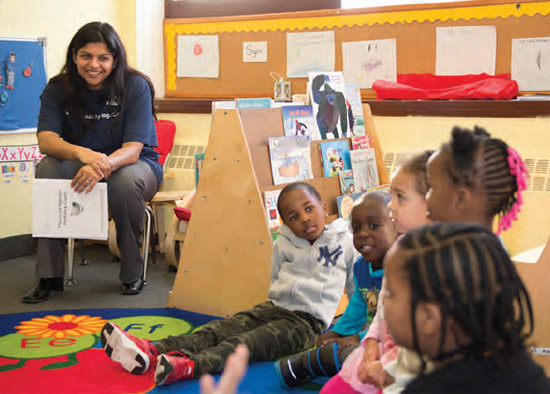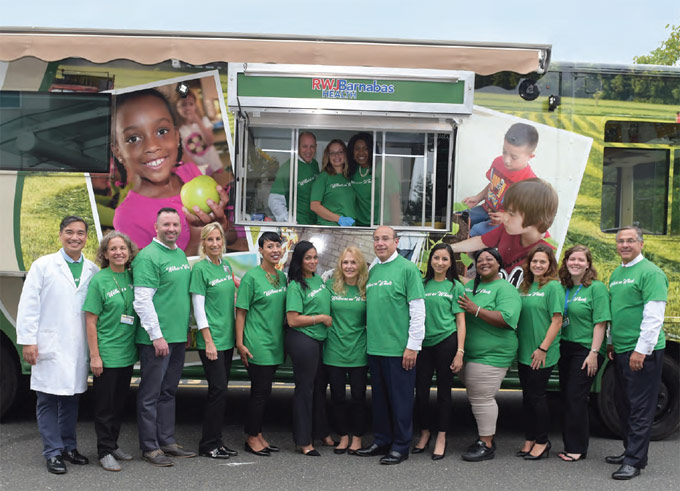Education

In the State of New Jersey, 12% of the total population, more than one million adults, have no high school diploma or the equivalent. Only 36.8% of the population has a bachelor’s degree or higher. The rate of educational attainment among the RWJBH county footprint varies widely, from Hudson County’s low 78% high school graduation rate to Monmouth County’s high 93%. According to the RWJBarnabas Health 2016 CHNA, “people with higher levels of educational attainment tend to have lower morbidity rates from acute and chronic diseases, independent of demographic and labor market factors.” This finding in the CHNA is represented in scores of research studies looking at the correlation between educational attainment and health outcomes.
A report from the U.S. Department of Health and Human Services’ Agency for Health Care Research and Quality found that, “of the various social determinants of health that explain health disparities by geography or demographic characteristics (e.g., age, gender, race-ethnicity), the literature has always pointed prominently to education.”
“Education leads to higher earnings and increased access to healthier food and safer homes. Better-educated individuals also are more likely to have a job — one with healthier working conditions, better health insurance, and higher wages.” — U.S. DEPARTMENT OF HEALTH AND HUMAN SERVICES’ AGENCY FOR HEALTH CARE RESEARCH AND QUALITY
Because education is such a key factor in health, social and economic outcomes, the SICI practice ensures that it is a key component in its programming. Conversely, the practice understands that by addressing other social determinants such as food insecurity and housing, educational outcomes improve. The Social Impact and Community Investment team takes a comprehensive and integrated approach, ensuring that educational components are woven into corporate and facility strategies, as well as seeks to partner with inclusive and diverse community-based organizations that address the education priority areas, which include:
- Early Childhood Development
- Family Engagement
- Family Health Literacy
- Professional Development
HEALTHY NUTRITION EDUCATION/ KIDSFIT EXPANSION
The U.S. Department of Health and Human Services states that, “Health literacy includes the ability to understand basic health information and health care services to make good health choices.” KidsFit is a health and wellness program developed by RWJBH that provides nutrition and wellness education and fosters healthy lifestyle and behavior for children, families and teachers in a classroom setting. It has proven outcomes indicating positive changes in lifestyle as they relate to food and activity behavior for both child and family members.
2019–2020 GOALS & KEY OBJECTIVES
GOAL 1
Increase the knowledge of a minimum of 10 schools and 2,500 children and
families about healthy eating behaviors, food choices and the connection
to health outcomes through a 10-week curriculum developed by RWJBH registered
dietitians and wellness experts, as evidenced by the number of classrooms
to adopt the program and improvement in healthy behaviors as a result
of the program.
KidsFit focuses on behavioral and healthy choices and involves parents, teachers and methods to help foster a culture of health and wellness in our schools. It will be taught to the teachers in collaboration with Rutgers Center for Childhood Nutrition and Research and brought to the classroom for children in grades 3 through 5.
- Update KidsFit Curriculum and refine metrics in collaboration with Rutgers University to target grades three through five.
- Collaborate with the New Jersey Education Association to promote KidsFit among educators throughout the state.
- Create E-commerce platform so that teachers can obtain the KidsFit curriculum.
- Conduct train-the-trainer seminars for New Jersey teachers with Rutgers University.
- Complement KidsFit curriculum with the Wellness on Wheels mobile unit to ensure all facets of healthy eating are addressed and provided.
- Enhance cultural competency of KidsFit Curriculum by ensuring that recipes reflect healthier versions of traditional dishes.
- Pilot KidsFit Pre-K curriculum at the Center for Childhood Education and Research at the Rutgers University institute for Food, Nutrition and Health.
GOAL 2
Advocate for sound federal, state, and local policies that advance favorable
conditions for sustainable school health and nutrition in the classroom.
Sustainable school health and nutrition in the classroom was a significant area of discussion and concern throughout the Food for Thought documentary process; therefore, continued education and advocacy is critical to this practice’s work. Food served, sold and advertised on public school grounds is regulated by federal law; however, state laws as well as local ordinances and policy priorities still play a large role in this area. As a result, collaboration with education entities to understand the education and nutrition policy agenda will be critical.
- Assess current policies with schools.
- Determine policy needs to address school health and nutrition issues.
- Establish advocacy partnerships, including with teachers, parents and students, to pursue sound federal, state and local policy changes.

PROFESSIONAL DEVELOPMENT
The Social Impact and Community Investment corporate team works with site leaders and throughout the system to advance the field’s knowledge and skills. The aim is to change the system and create a corps of intellectually curious and innovative thinkers who are able to lead the SICI within RWJBH facilities and to work effectively with the surrounding communities.
36.8% OF NJ’S POPULATION HAS A BACHELOR’S DEGREE (OR HIGHER)
GOAL 1
Create a team of a minimum of 20 RWJBH social change leaders that help
create socially-connected and economically-thriving resilient communities,
as evidenced by demonstrated understanding of how to manage practice operations
and possession of a solid grasp of industry contest for SICI content and
how it impacts specific objectives.
Social Impact and Community Investment is an expansion of the RWJBarnabas mission, therefore, it is mission critical to ensure that the goals, objectives, tactics, and vernacular are thoroughly understood and embraced throughout the system. To do this it is critical to build expertise at each facility and beyond. The hope is that this will begin with experts in each facility, but will extend to each employee.
- Establish a learning platform (SICI University) that enables the system’s social impact and community investment practice leaders to enhance their knowledge and skills as social change agents by providing professional development through a range of modalities that are on site, in person and on-line. This will facilitate ease of access to learning and engagement. SICI University will include two tracks.
- Establish partnerships with institutions and organizations that can provide additional learning opportunities.



